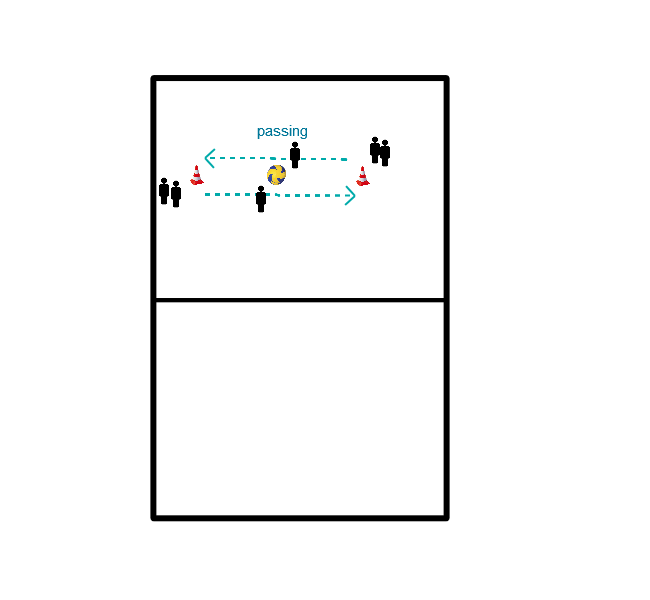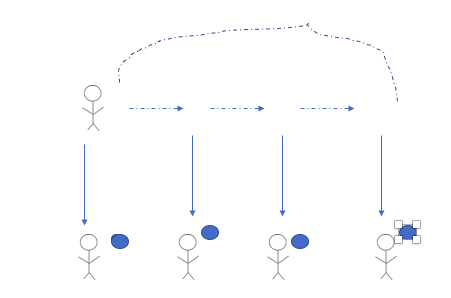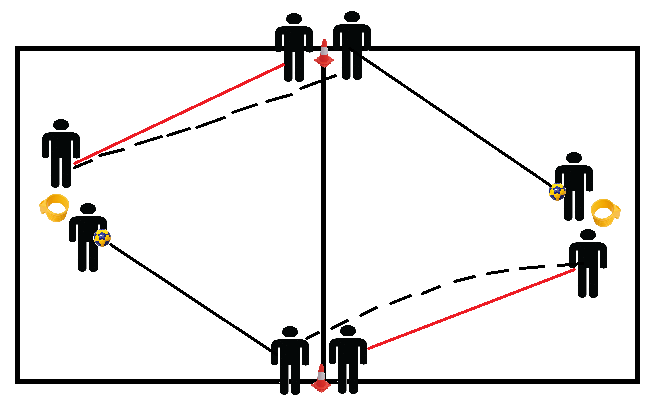Korfball drills for technique passing / attack
- The ball is thrown in a circle.
- A child starts behind the person standing next to the person with the ball.
- The ball must be overtaken.
- The rest has to make sure that the ball is thrown over.
- Place two posts where they usually are during a game.
- Then place two pilons at the far left and far right on the center line.
- Ideally, this exercise is done with 8 people, more is possible, less than 8 doesn't work.
- At each post or pilon two people are standing, one person under the post starts with the ball (on both sides).
- This person throws the ball to someone near the pilon on his right and runs after the ball.
- This person then throws the ball to the other post, and the second person near the pilon goes for a through-ball.
- Now the ball is under the post again and the round starts over again.
Arrangement:
(Black line: throwing and running after the ball) (Black dotted line: throwing ball) (Red line is running for a through-ball)
- 4 posts and 4 groups,
- 2 Balls: aim to think how to run freely when building up.
- 4 versus 4 with 2 posts:
- trying to throw a long ball when building up by running deep,
- running free through tempo change.
- Pause a few times to discuss running free and tempo changes;
- learning to find an angle,
- or when the angle is fixed, the long diagonal throw.
- 2 posts and 3 groups,
- defending party intercepts,
- builds up and goes on to attack the box;
- Build up starts in defence!
- You put up four poles in a square,
- in the middle of the four poles you put down a pilon.
- four children will be passers at the poles and
- the rest of the children will stand by the pilon in the middle.
- First, you can choose that the attackers have to take through-balls at the poles.
- It doesn't matter which pole, they may run at the same pole a maximum of 2 times in a row.
- You can choose this, so they have to run a lot.
- The children also have to score twice, the person who does this first may definitely switch positions with a passer, the other may switch as well as soon as they score twice.
- After that you can choose to let the children do free balls, penalty throws, dodge-balls, etc.

- Put pilons about 6 meters apart. Divide the group into 2.
- In the case of five, one group of 3 and a group of two.
- The goal is to keep the ball in the middle between the pilons at all times.
- As soon as a player receives the ball, the player must be at the centre of the other side.
- After you have passed the ball, you join the back row on the opposite side.
- NB: Nobody stands still and tries to see what happens at all times
- Do not arrive too early or too late.
- Throwing while moving.
- After five minutes switch side (left hand).
- Make pairs, at each post a pair.
- We are now going to use the posts lengthwise, namely one player of the pair attacks the post opposite to him or her.
- One player of the opposite post does the same.
- How does this work?
- Of each pair there is a number 1 and a number 2.
- Number 1 is going to defend his post for a minute and a half against the other number 1 of the post opposite to him.
- When the number 1 of a post has had a chance, the other number will attack and so there will be a change of function (and of post, because everyone is defending his own post).
- So there is always a change of function if the attacker has lost the ball.
- As a player, you are attacking as well as defending for a minute and a half
At a distance of +/- 15 meters from each other, make two compartments with 4 pilons of 1.5 x 1.5 meters.
Make two teams with an equal number of players.
- Each team has its own compartment.
- The other team tries to conquer the other team's square.
- This happens when 1 striker is standing in the opponent's square and the ball is played by a team-mate.
- They get 1 point. No other players are allowed in the box.
- When the defence intercepts the ball, they may immediately start the attack on the opponent's square.
Variation:
- on time
- with points
- of both teams 1 player is allowed in the box
- no limit on the number of defendants in box
- no limit on the number of attackers in box
- customize size of box
- distance between boxes
- Put 3 pilons in a triangle.
- At pilon 1 and 3, there's one person.
- Person at pilon 1 has a ball, person at pilon 3 runs to pilon 2 and runs back.
- Person at pilon 1 throws the ball when he or she arrives at the pilon, then the person at pilon 1 runs to pilon 2 and back again and gets the ball when he/she arrives at pilon 1 again. And so on.
- 2 people at each post and a ball at both posts.
- Throw the ball to the other side and run after it, makes a run.
- The others who are facing each other do the same.
- You make a run with the second person at the same time. The one who passed first throws the ball to the other side and runs for it. That's how roles are switched.
- The passing is important because there is a fairly large area between the passer and the one who has to run.
- One ball per groups of two/three.
- The players pass until they reach a post.
- At the post both players may shoot once.
- Then they have to pass again to another post.
- All groups just cross each other.
- Whichever team to achieve 15 goals first wins(optional).
- 4 children are standing next to each other, about 5 meters apart.
- 1 child is going to do the exercise:
- Receives the ball at the first pilon, returns it to the player on the other side, and moves on to the second pilon and so on.
- At the back pilon he returns with a full sprint.
- Then switch, everyone moves a place, number 5 does the exercise now.
- Everybody has their turn. Possibly everyone could go 2-3x.

Piggy in the middle:
- You're all standing in a circle and there's one piggy in the middle.
- Briefly repeat how to throw with two hands and how to throw with one hand.
- During this exercise the throwing will be looked at, the good catching will be discussed later on.
Variations: easy to difficult
1. throwing with 2 hands
2. throwing with 2 hands (with tag)
3. Throwing with 2 hands (with a tag and several piggies)
4. Throwing with 2 hands (but throwing with 1 hand is also allowed)
5. throwing with 1 hand
6. throwing with 1 hand (with tag)
7.throwing with 1 hand (with a tag and several piggies)
Based on how goed the exercise is performed you can perform the variations in the exercise.








